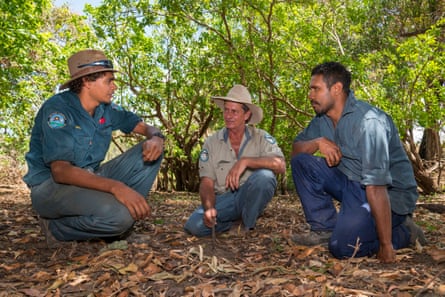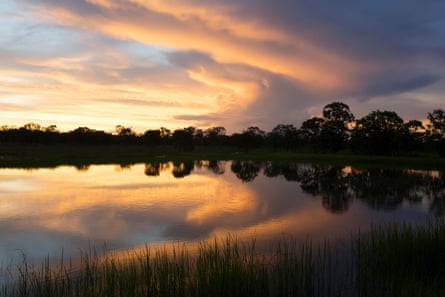Only a small number of vast natural landscapes remain on Earth – wild regions where ecological processes function normally and movements of wildlife remain largely unfettered by the fragmentation of habitats. These few places include the Amazon basin, the boreal forests of Canada, tundra of Siberia, the Sahara Desert, and the Australian Outback.
It has become increasingly apparent to modern science what Indigenous people have understood for centuries: that even in these large, natural ecosystems, the fate and condition of nature lies in the hands of the people who live on, know, respect and manage that land.
After five years of peer-reviewed studies about the issues and challenges and opportunities facing the 70% of the Australian continent the outback covers, it’s clear that there is a seemingly counter-intuitive relationship here: not only do people need nature, but nature also needs people.
The outback has been the home of Indigenous Australians for about 50,000 years. Over this period, traditional owners have tended, shaped and nurtured the landscape. Reciprocally, the landscape has helped to forge Indigenous identity and culture. In Pew Charitable Trust’s latest study – My Country, Our Outback: Voices from the Land on Hope and Change in Australia’s Heartland – 12 personal stories are included to explore that relationship, its modern manifestations, and to recognise that there are new elements in this landscape, and new people and enterprises are now responsible for caring for this magical country.

There are especially mysterious and spectacular places in the outback – Kakadu, Uluru, the Kimberley – icons that draw visitors from the nation and beyond. These are parts of a whole, places embedded within a vast natural landscape and dependent upon the greater area for their ecological health.
Importantly, the outback is now a modern landscape. Many graziers and Indigenous rangers use helicopters to traverse their country. They use laptops and satellites to check for fires and the state of water tanks in distant paddocks. Some outback stations now engage in carbon farming and tourism businesses as well as grazing cattle and sheep.
Today, however, the long-term health of the outback is under threat. Across vast areas, there are fewer land managers now than at any time in the past 50,000 years. This is causing problems – such as the uncontrolled spread of feral animals, noxious weeds and wildfires – that, unless addressed, will result in a continued decline in the health of the heart of Australia.
With little understanding of the potential consequences to nature or future inhabitants, successive generations of settlers introduced a cavalcade of non-Australian plants and animals to the outback. Many of these species, such as foxes and cane toads, have spread across vast areas and taken a substantial toll on native species. That toll will continue to rise unless these feral animals and weeds are controlled, which cannot happen without people.
Since European settlement, much traditional management of the land by Indigenous people has been disrupted. Where once there was a careful, skilful and necessary manipulation of fire that was attuned to the environment, fire now occurs wildly with unprecedented ferocity, extent and detrimental impact. It will remain so until people reclaim control.

Pew’s study presents many cases of landholders seeking to control weeds and feral animals. They are not seeking to return the country to a pre-industrial Eden. Rather, the country will be more diverse, productive and resilient when and where managers can reduce such threats to its environmental integrity and functioning.
To understand the effects of feral animal species and control them successfully, land managers need to adopt integrated whole-of-landscape approaches. “Rewilding” – an attempt to restore the major ecologically important native species to a landscape that is degraded or from which those species have been lost – offers such an option.
Indigenous ranger groups in some remote parts of the outback form the front line in surveillance efforts, looking for new incursions of these and other feral animal and weed species and then promptly seeking to control those incursions while it is still relatively practicable. Such front-line biosecurity effort is cost-effective because it eradicates a problem when it is still small and controllable.
In some outback regions, the abundance and impacts of feral pests may also be moderated through the reintroduction of dingoes and through improved fire management.
Today there is much evidence that many threatened native mammal species have persisted better in areas where dingoes remain abundant than in those where they have been eradicated or reduced by sustained poisoning campaigns. This is because dingoes can reduce the abundance of introduced foxes and feral cats. These two feral predators exert far more destructive tolls on native wildlife than dingoes do. Dingoes can also reduce grazing pressure by overabundant kangaroos and feral goats.

Conversely, many pastoralists (particularly those grazing sheep and goats) regard dingoes as significant killers of their stock, and hence a serious pest that should be eradicated from their lands. This is one of the most difficult outback land management issues to resolve. New management approaches – such as use of guard dogs and fencing and targeting of individual problem dingoes – rather than indiscriminate persecution hold promise for resolving the issue in many regions.
It may seem counterintuitive, but much of the decline in biodiversity in the outback is occurring in areas that are most remote from population centres and human activity. This is occurring because many of the feral animal, weed and fire threats now occur almost pervasively across the Outback and, especially where there are no managers attempting to control them, their detrimental impacts are increasing. More so than ever before, the country needs people to care for it.
One striking feature of the outback over recent years is the spectacular growth in the number, extent and success of Indigenous Protected Areas and Indigenous Ranger schemes.
These represent far more than simply changing the officially recognised purpose of a parcel of land. They are demonstrations of commitment to looking after country, and of the particular applicability and fit of Indigenous knowledge to land management in Australia. These programs have nurtured land, communities and culture and have contributed to far better governance across large areas of the outback.

The 75 Indigenous Protected Areas currently in place cover an area 10 times the size of Tasmania, and make up almost half of Australia’s national estate of conservation areas. Significant environmental, economic and social benefits are being delivered and created, however these 67 million hectares of biodiverse country is being managed by only 800 fulltime rangers and 2500 part-time Indigenous staff. There is an undeniable case to boost funding support for these successful programs and support Indigenous-led conservation management for the long term benefit of the outback and on behalf of all Australians.
The outback has a story, power and value far beyond the superficial layering of topography, tenure or environment. The land gives meaning to life, and sustaining its health will ensure it remains the beating heart of this nation.
This is an edited extract from The Pew Charitable Trust’s new study: My Country, Our Outback: Voices from the Land on Hope and Change in Australia’s Heartland

Comments (…)
Sign in or create your Guardian account to join the discussion